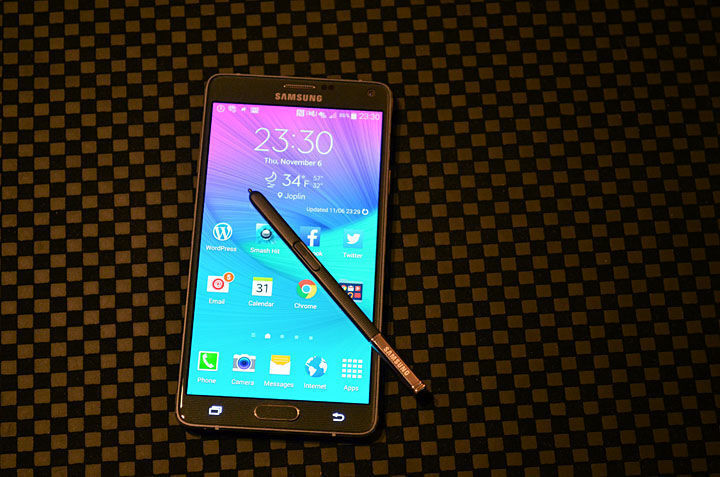REVIEW: Galaxy Note 4 an awesome phone, even without the stylus
Published 8:45 am Monday, November 17, 2014

- The Samsung Galaxy Note 4 is an outstanding smartphone. Despite a higher-end price of about $300 with a two-year contract from AT&T, the device's inclusion of other peripherals such as a heart rate monitor and expandable memory make this one of the best phablet bargains.
Before I became a BlackBerry user, I swore by Palm Pilot devices. The little tablet thingy was perfect for organizing dates, phone numbers and tasks in an easy-to-use format that easily synced to my computer. I also had a portable Palm keyboard I used to pound out meeting notes
The signature implement of the Palm Pilot was the stylus. The little plastic screen tapper was the key to the device’s portability — writing characters in a specific area of the screen eliminated the need for a keyboard.
Trending
Since Palm’s fading into obscurity, the stylus has been seen mainly as an accessory for iPad users and Nintendo DS owners. It wasn’t until Samsung introduced the Galaxy Note that the stylus starred in a smartphone.
The 2011 debut of the Note was a home run: It was arguably the first phablet, the first smartphone with that big of a screen. These days, a 5-inch diagonal screen is commonplace thanks to the success of the Note.
Samsung, a company that has no problem with releasing multiple products each year, is now up to the fourth in the Note series. The Galaxy Note 4 features some sweet upgrades, including an incredible display, powerful camera and solid construction.
The stylus is another story. It feels more like a gimmick or toy instead of a serious productive tool. Aside from precision text selection, the most use I got from it was for entertainment-related functions, such as drawing over pictures.
On the Note 4, however, it fits right in. After testing out a Note 4 on loan from AT&T for about a week, I found it a really fun smartphone to use.
Screen size
Trending
The Galaxy Note 4 is big, of course. But that monster 5.7-inch screen is kept in a case that’s not as tall as an iPhone 6 Plus or the Note 3, so I didn’t have any pocket problems. The size may sway some, but the way the smartphone market is going, this relative screen size isn’t going away anytime soon.
And about that screen: Samsung packed the device with a 5.7-inch Quad HD Super AMOLED display that has a resolution of 2560 by 1440.
It’s gorgeous. Bright, vivid and sharp, everything I watched or played looked incredible. Photos looked better on that screen than they did on my computer once I uploaded them and got them into Photoshop.
As for video: Any movie or TV show I watched flowed smoothly, including episodes of “The 100” from a CW Network app and “Cosmos” from Netflix.
It’s an easy screen to see, which means it’s easy to share. Showing a funny YouTube video or Vine is no hassle at alland can be pulled up without that awkward lull in conversation.
I had some issues around Joplin getting a strong data signal with the Note 4, but my issues were too sporadic to blame on the device. It could have been a series of bad days for AT&T’s network (happens to everyone), or it could have been bad spots I happened to check.
It has the processing power to keep up with anything. The model I tested featured a 2.7 GHz Quad Core processor with 3 GB of RAM. “Smash Hit” and “Temple Run 2,” both video games with 3-D rendering, didn’t suffer a single hang.
Upgrades
The Note 4 has the same set of Swiss Army knife-tools as the S5: It is equipped with a full heart rate monitor and pedometer. That means the S Health application gives a little bit more precise picture than any other native fitness app, and doesn’t even require a separate bracelet such as a Fitbit.
The version of Android KitKat doesn’t have the same mess of settings as the S5, however. There’s still a crapload of them — Samsungs have so many settings — but they are better organized and easier to find. There’s also the typical amount of redundant Samsung bloatware that users will quickly delete.
Multitasking has also been improved a little bit. More apps can share a screen, so copy-pasting something read from the Internet into a text message can be done pretty easily.
Arguably the biggest upgrade from the Note 3 is the chassis. All those tools are housed in a strong metal frame that feels solid and durable, more so than any other plastic-filled Samsung device I’ve worked with. The back panel is coated in a soft, rubberized texture that provides excellent grip: I had no problems hanging on to the Note like I did with the iPhone 6 Plus or the LG G3.
And the best part: That panel can be removed for access to the battery, SIM card and an expandable memory slot. It’s an old-school feature among a trend of unibody phones, but I appreciate it.
Cameras
The Note 4 features the best cameras I’ve seen on a Samsung device. The front-facing selfie 3.7 megapixel camera has an f/1.9 wide-angle lens that lets users capture more of the scene. That means more people can get into a selfie. It’s awesome to get crowds in comfortably without having to smash together.
The rear-facing 16 megapixel camera comes with image stabilization and enough exposure space to get some outstanding low-light shots. Real talk here: The times and places where we are having the kind of fun that calls for pictures are usually dimly lit. The Note 4 is equipped for that very situation. I took pictures during a Halloween night out on the town and got a lot of keepers, from group selfies to incredibly sharp pictures of the performing band.
The optical image stabilization provides a respectable zoom, but it doesn’t add much sharpness to an image zoomed to the max. Images zoomed in up to 2x will be fine, but the full 8x that the camera offers will leave a lot of photographers dissatisfied.
There are plenty of different shooting modes, but the most important one is right on the viewfinder: The HDR toggle is perfectly placed. However, looking at my images, it’s hard to tell which shots are truly HDR shots. The difference between them was not obvious.
Video is just as capable: The Note 4 has slow-motion and smooth video functions that take advantage of the processing power, but the user interfaces aren’t as intuitive. The results aren’t as good as the similar functions on an iPhone 6. The camera also has issues getting a focus lock at something close up, which will frustrate people who like to capture detail photography.
Pen
As for that stylus, it was handy, but I never felt like I was able to use the full functionality of it.
As a working stylus, the S Pen substitutes wonderfully for a finger and leaves the glass as clean as dishes from the washer. Samsung even throws in a variety of replaceable nubs for the stylus.
The S Pen has a button on it that, when pressed above the screen, activates a submenu of options. With it, you can quickly take a screenshot and start writing things on it. Or you can take a note on a sticky note-like sheet of digital paper, and have it remain on your desktop.
And if you like writing text messages, you can do that as well. At any text entry point, I could tap into a mode where I could actually write my note, then the phone would convert my scribble into a text message. It would even differentiate between capital and lowercase letters. This was not always successful — either because my writing is terrible or the device needs more work at text recognition.
The button is at an awkward place on the pen, and it’s stiff. It’s hard to press it while hovering over the screen. And the four options you get are somewhat limited: You get either a shortcut to a memo, take a screen shot for some drawing or two selection modes. Still, that’s a massive improvement over other devices that use a stylus only as a replacement for a finger.
There are plenty of awesome things you can do with the pen. Take a picture of someone or something and write a note on top of it, for instance. Or jot a quick note down as a reminder. (I would love to see future versions of this have an alarm function, so that the device could remind me of the note I wrote.) I feel like I only scratched the surface of what the pen can do. There has to be some great sketching or drawing apps that take advantage of the device’s ability to sense pen pressure.
But likely, many will treat the stylus as an afterthought. It’s not necessary for any of the device’s functions, and if it gets lost, no big deal — the device is still awesome.
Summary
Even with the gimmicky S Pen, the Galaxy Note 4 is an outstanding phone. Despite its higher price tag, it’s actually one of the better bargains considering everything it does. Its onboard pedometer and heart rate monitor eliminate the need for a separate bracelet device such as a Fitbit. And its expandable memory slot can accommodate up to 128 GB, so upgrading storage is much less expensive than on an iPhone.
Because it’s running Android, it’s flexible enough to handle a variety of files and apps. It is also compatible with a variety of peripherals and wearables, such as Galaxy Gear. And it has enough memory and processing power to remain versatile and functional long after a two-year contract is up.
The Galaxy Note 4 is available from AT&T for about $300 with a two-year contract and about $826 without. If you’re OK with going big, this is the device for it.





